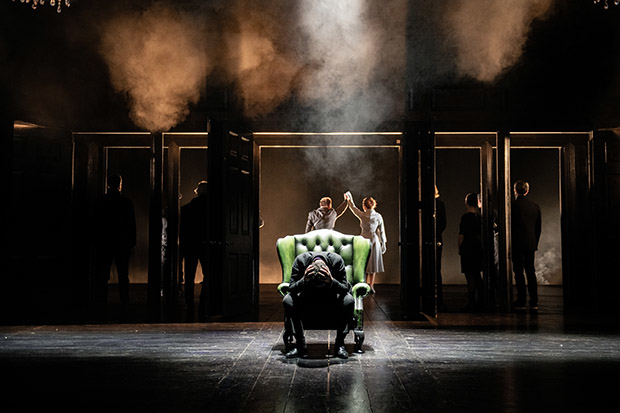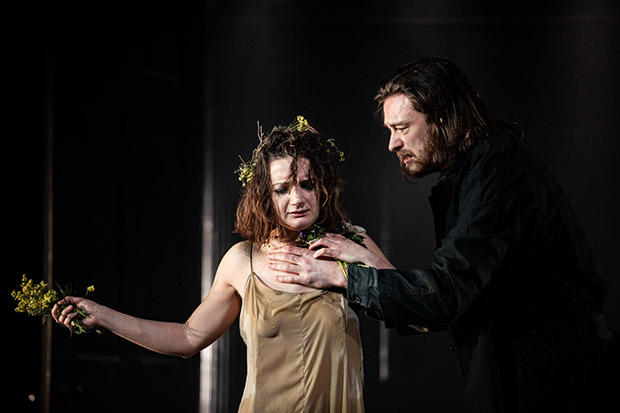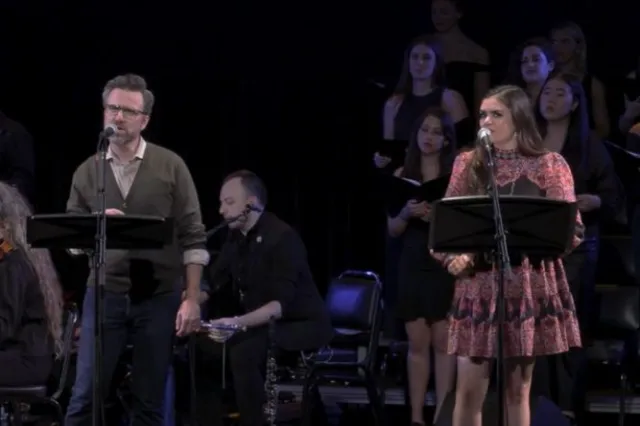A Gender-Nonconforming Hamlet in Brooklyn
Ruth Negga stars as the famously indecisive Danish prince at St. Ann’s Warehouse.

(© Teddy Wolff)
The air at St. Ann's Warehouse is rich with incense as we are shuffled quickly into the DUMBO theater, like mourners taking our seats for a state funeral. Director Yaël Farber smartly recognizes that such memorials are opportunities to reflect not just on a single life, but life as a whole and its meaning (if, indeed, it has any). It's a powerful way to open her boldly sensory production of William Shakespeare's Hamlet, starring Irish actor Ruth Negga in the title role. Originally produced for Dublin's Gate Theatre in 2018, Farber's Hamlet has a few spectacular moments and the long stretches of tedium between them — somewhat like life. As a cross-gender production of Shakespeare's most famous tragedy, it's a little more than dry, but less than misandry.
The King of Denmark (Steve Hartland) is dead to begin with. Cold under a plastic shroud, he is viewed and then carted away like old furniture as his brother Claudius (Owen Roe) quickly assumes the old king's throne and his wife, Gertrude (Fiona Bell). "Thrift, thrift, Horatio! The funeral baked meats did coldly furnish forth the marriage tables," explains Hamlet (Negga) to his best friend (Mark Huberman) about why the marriage follow'd hard upon his father's funeral. But how does he explain the fact that he, the dead king's first-born, is not now king himself? Even if he proves his uncle's treachery, what will he do with that information? What is even the point of his existence?

(© Teddy Wolff)
Hamlet spends much of the three-hour, 15-minute runtime of this play wrestling with those questions. Farber decorates his existential quandary with a relentlessly dark production. Susan Hilferty's set depicts Elsinore castle as an unending series of heavy wooden doors (so many options, so little movement). Hilferty's costumes are also mostly funereal (with the exception of Gertrude's powder-blue queen dress, which seems to add insult to injury). John Torres's lighting remains shadowy throughout.
In a Beckettian flourish, gravediggers in bowler hats and heavy eye makeup (Will Irvine, Ger Kelly, and Gerard Walsh) stalk the stage, and not just during their allotted scenes. Kelly has a hauntingly lovely voice, and the ballads with which he underscores key moments cast a layer of Celtic gloom over an already gloomy play. Composer and sound designer Tom Lane allows us to hear the obedient masses cheering in unison just beneath the upstage balcony as Claudius, wearing a general's uniform, announces his union with Gertrude. Men with automatic rifles follow him everywhere, occasionally pointing their weapons at us. This is obviously a highly authoritarian vision of Denmark, where conformity is enforced by violence (but at least Hamlet gets to attend Wittenberg for free).

(© Teddy Wolff)
Farber has triumphed with heavy atmospherics before at St. Ann's Warehouse, most memorably in 2012 with Mies Julie. The mixture of music, movement, and earthly elements in that play still haunts my memory, and I have no doubt that several of the arresting stage pictures Farber has created here will join that penumbra of theatrical spirits: a curtain of plastic falling across the stage like the membrane between the living and the dead; Gertrude resting in crucifix position on her dark red bed; Ophelia (a heartbreakingly fragile Aoife Duffin) screaming for Hamlet as she soaks in the rain, which is isolated to a single gravelike rectangle. These images will stick with me for a long time.
Unfortunately, due to a shaggy cut of the text and occasionally indulgent performances, the production has a tendency to drag. Not every pregnant pause gives us pause, and as the performers repeatedly peer into the yawning void of their own mortality, we begin to yawn a bit ourselves.

(© Teddy Wolff)
Luckily, Negga leads the cast with a memorable portrayal of the Prince. She is by no means the first female actor to take on Hamlet (a part famously played by Sarah Bernhardt in the 19th century), nor will she be the last (Cush Jumbo will play the Dane at London's Young Vic this coming summer). But Negga's purposefully vacillating performance seems to embody the essence of Hamlet's dilemma: Trapped between school and court, prince and king, male and female, black and white, her Hamlet inhabits a permanent state of the in-between. While all of the characters refer to Hamlet with male pronouns, Negga presents an androgynous figure, physically smaller than any of the men onstage and completely distinct from the Viking he-man Laertes (an imposing Gavin Drea). Could this be the reason why Hamlet's uncle leapfrogged him to the throne? Is fascist Denmark unready for such an obviously queer leader?
Even if it's not the most nail-biting Hamlet I've ever witnessed, Farber's production opens the possibility that Hamlet's legendary dithering might not be the only explanation for this tragedy, which is rich enough to yield new discoveries with each staging.








